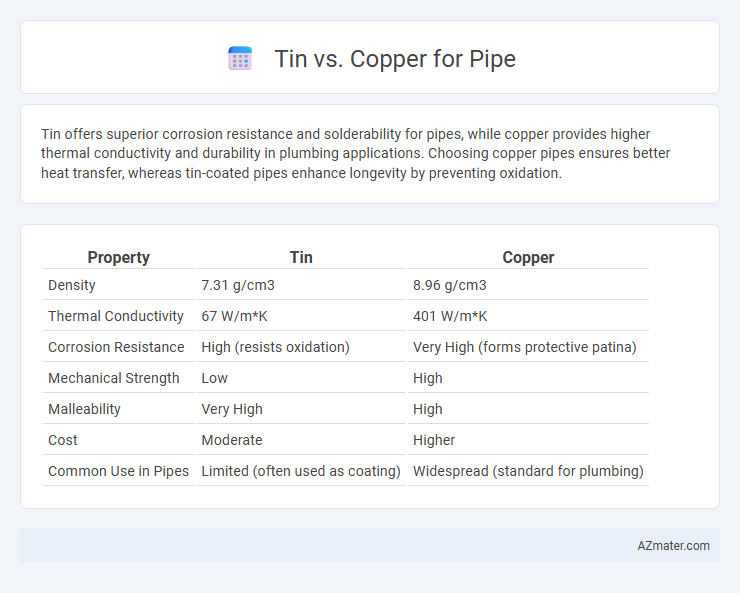Tin offers superior corrosion resistance and solderability for pipes, while copper provides higher thermal conductivity and durability in plumbing applications. Choosing copper pipes ensures better heat transfer, whereas tin-coated pipes enhance longevity by preventing oxidation.
Table of Comparison
| Property | Tin | Copper |
|---|---|---|
| Density | 7.31 g/cm3 | 8.96 g/cm3 |
| Thermal Conductivity | 67 W/m*K | 401 W/m*K |
| Corrosion Resistance | High (resists oxidation) | Very High (forms protective patina) |
| Mechanical Strength | Low | High |
| Malleability | Very High | High |
| Cost | Moderate | Higher |
| Common Use in Pipes | Limited (often used as coating) | Widespread (standard for plumbing) |
Introduction to Tin and Copper Pipes
Tin pipes offer excellent corrosion resistance and antimicrobial properties, making them ideal for water supply systems and historical restoration projects. Copper pipes provide superior durability, thermal conductivity, and ease of installation, widely used in residential and commercial plumbing. Both materials demonstrate long-lasting performance, but copper remains the preferred choice due to its strength and widespread availability.
Historical Use of Tin and Copper in Plumbing
Copper has been a preferred material in plumbing since ancient Egypt and Rome due to its durability and corrosion resistance, while tin was commonly used as a coating metal to protect other pipes from rust and corrosion. Historically, tin was often alloyed with copper to create bronze, widely used in pipe fittings and water systems during the Bronze Age. The transition from tin-coated iron pipes to solid copper pipes marked a significant advancement in plumbing technology, improving water quality and system longevity.
Physical Properties: Tin vs. Copper Pipes
Copper pipes exhibit superior thermal conductivity and higher tensile strength compared to tin pipes, making them more durable under pressure and temperature variations. Tin pipes have lower melting points and are softer, which limits their use in high-stress plumbing applications. Copper's corrosion resistance and ability to withstand extreme temperatures make it the preferred material for long-lasting and reliable piping systems.
Durability and Longevity Comparison
Copper pipes exhibit superior durability and longevity compared to tin, as copper resists corrosion, high temperatures, and pressure fluctuations more effectively. While tin has been historically used for coatings or soldering in plumbing, it lacks the structural strength and corrosion resistance needed for long-term pipe use. Copper piping can last over 50 years in typical residential applications, making it a more reliable choice for durability and sustained performance.
Corrosion Resistance: Tin vs. Copper
Copper pipes exhibit superior corrosion resistance due to their natural ability to form a protective oxide layer, which prevents rust and deterioration over time. Tin, often used as a coating on copper or steel pipes, enhances corrosion resistance by providing an additional barrier against moisture and chemical exposure but lacks the structural strength of pure copper. In environments prone to acidic or alkaline conditions, copper outperforms tin by resisting corrosion without compromising pipe integrity or longevity.
Health and Safety Considerations
Copper pipes are widely preferred for plumbing due to their durability and resistance to bacterial growth, which enhances water quality and reduces health risks. Tin, often used as a protective coating on other metals, can pose health concerns if ingested in large amounts, making it less suitable for potable water systems. Copper's natural antimicrobial properties and non-toxic nature ensure safer drinking water compared to pipes with tin coatings.
Cost and Availability
Copper pipes are generally more expensive than tin pipes due to higher raw material and manufacturing costs, but their durability often justifies the investment for long-term applications. Tin pipes are cheaper and more readily available in certain regions, making them a cost-effective option for short-term or less critical plumbing needs. Availability of copper is widespread globally, supported by a robust supply chain, whereas tin supply can be limited and more susceptible to market fluctuations.
Installation and Maintenance Requirements
Copper pipes offer straightforward installation due to their flexibility, durability, and compatibility with various joining methods such as soldering and compression fittings, requiring minimal specialized tools. Tin-coated pipes require careful handling during installation to avoid damaging the protective tin layer, which prevents corrosion but can increase setup time and the need for protective measures. Maintenance for copper pipes is generally low, with occasional inspection for corrosion or leaks, while tin-coated pipes demand regular monitoring to ensure the tin coating remains intact to prevent corrosion and prolong pipe lifespan.
Environmental Impact and Sustainability
Tin is less commonly used than copper in piping but offers a lower environmental impact due to its abundance and easier recycling processes, reducing resource depletion and energy consumption. Copper pipes, while highly durable and recyclable, require intensive mining operations that contribute significantly to habitat disruption and carbon emissions. Choosing tin over copper can enhance sustainability in plumbing by minimizing ecological footprints and fostering circular economy principles through efficient material recovery.
Choosing the Right Material for Your Plumbing Needs
Copper pipes offer excellent durability and corrosion resistance, making them ideal for long-term plumbing installations. Tin, often used as a coating for soldering copper joints, enhances joint strength but is not suitable as a primary pipe material due to its softness and lower pressure tolerance. Selecting copper pipes ensures reliable water flow, reduced risk of leaks, and compliance with most building codes, while tin's role remains limited to facilitating secure pipe connections.

Infographic: Tin vs Copper for Pipe
 azmater.com
azmater.com